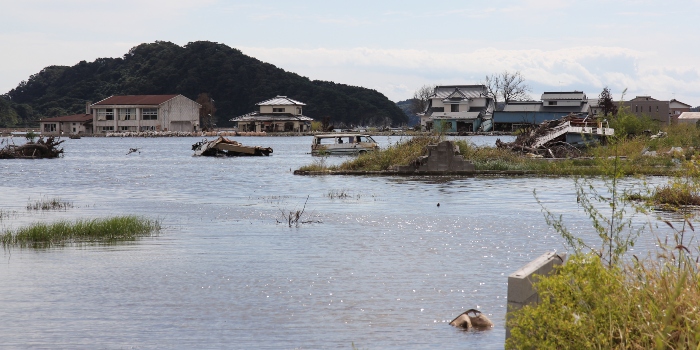Since 2008, Professor Karsten Arnbjerg-Nielsen has been working with extreme rains and flooding in Denmark. He has now compiled his research into a doctoral dissertation.
“Panta rhei”—“everything flows”—is a claim attributed to the Greek philosopher Heraclitus, approx. 400 years BCE. He used these words to describe the world as chaotic and in constant flux, which is highly relevant these years, where we have seen the climate change at an unprecedented pace, and we are trying frantically to adapt to new weather conditions.
Water tends to cause enormous damage when flowing into unwanted places. So Panta Rhei is an apt name for the large European research project on hydrology, in which Professor Karsten Arnbjerg-Nielsen has participated in recent years. His general framework has been in-depth work on the risk of floods and how to deal with them. Panta Rhei therefore also forms part of the title of his doctoral dissertation, which he defended on 28 January.
It all began in 2002, when an unusually heavy rain storm caused major flooding in Greve Municipality south of Copenhagen. As a consultant engineer at COWI, Karsten helped investigate the case.
“It was, if you’ll pardon the expression, incredibly exciting. We had been talking about a torrential rainstorm that occurred in 1959, and now we experienced one of equal magnitude. But in the following years, this happened in several similar places throughout the country, and I started questioning what in the world was going on,” he says.
"We talk a lot about temperatures in relation to climate change, but what’s going to affect us most is the water."
Karsten Arnbjerg-Nielsen
How much rain can we expect in future, how will it contribute to flooding, and what action should be taken at official levels to protect us against it? These are the kinds of questions that Karsten, in collaboration with several PhD students, have tried to answer using statistical models.
A year ago, he was given the opportunity to take half a year’s leave to stay at the German research centre GeoForschungsZentrum in Potsdam, home to some of the world’s foremost researchers within this area. This became a great opportunity for him to sum up his research results in a doctoral dissertation.
Dykes vs. nature
Karsten has made many media appearances, and has, among other things, advocated that dykes are not always the best solution to the problems:
“Dyke building is detrimental to nature—shore meadows may be destroyed, natural areas like the Wadden Sea may suffer, and home owners may get into heavy conflicts about how high the dykes should be built and who should foot the bill,” he says, adding that dykes furthermore provide false reassurance.
“We will always witness an incident that the dyke can’t resist. There is a great difference between an ‘ordinary’ storm surge and an event that might occur every 150 years, so what should we build for? And if we surround all our big cities with dykes, where does that leave room for nature? There may be houses in small coastal towns that we decide not to protect. Where to draw the line? If you leave the decisions up to the locals, you’ll have dykes everywhere. Or you’ll see the same situation as in many other countries, where the poor are left to live in the areas threatened by floods.”
Today, it is easy to identify areas where the risk of flooding is too great for housing to be built. Alternatively, you can construct houses that are completely flood-proof—if residents are aware of the risk at all times and remember to close their doors and windows. But many houses have been built far too close to the sea or on low-lying plots without any consideration for the risk of flooding. In Karsten’s opinion, this approach should be discontinued immediately, and a major political task lies ahead in deciding the criteria according to which existing construction should be secured.

Many areas were flooded by the 2011 tsunami in Japan and left permanently under water. This will probably happen in several other places.
From rainwater to seawater
He himself will continue working on new types of statistical models that will provide better understanding of rain, just as he will look at new nature-based methods to handle urban rainwater. And now he includes not only rainwater, but also seawater in his models.
“If we comply with the Paris Agreement—and that’s a big ‘if’—we’re looking at a future in which our costs for rainwater flooding will double. But the costs will increase more than a hundredfold when seawater levels rise. We simply need to deal with that,” he says.
The regular cycle of the seasons may change dramatically, and several major events may occur simultaneously. There are plenty of risk scenarios for a hydrologist to consider:
“We talk a lot about temperatures in relation to climate change, but what’s going to affect us most is the water.”